
Example 1: Movement I, measures 1 - 3. Succession of Events

Comprehensibility and Function in Webern's Six Pieces for Orchestra opus 61
Jeri Kotani
Introduction
Anton Webern's Six Pieces for Orchestra, Opus 6, provides an interesting compositional insight into style as manifested in Webern's work during the Atonal Period. It is my conjecture that these manifestations of style developed, in part, from compositional solutions that Webern engineered to ease the conflict between his growing preoccupation with 'comprehensibility', i.e., structural coherence, and his compositional choice of avoiding thematic repetition in the Six Pieces for Orchestra.
In his published lecture notes, The Path to the New Music, Webern directs all discussion concerning his perspective on evolution of musical language to the general aesthetic principle of comprehensibility. Although the Six Pieces (1909) antedates the presentation made in The Path to the New Music (1932), Webern's observations on principles effecting comprehensibility are still applicable to the Six Pieces.2 Webern made the following apt remarks:
The ultimate principle
in all presentation of an idea is the law of comprehensibility.3
What is the easiest way to ensure comprehensibility? Repetition. All formal construction is built up on it, all musical forms are based on this principle.4
The principle of repetition as a structural device is inherent in the construction of traditional forms such as those in an ABA, ABACABA format, i.e., sonata form, rondo. This is not to disregard the principle of differentiation which is an integral concern of formal design. Repetition however, is the major practice that helps to establish relatedness.
The fact that the
Six Pieces for Orchestra "represent short song forms"5 i.e., general
ternary (ABA) structure, should imply an adherence to a traditional structural model that normally depends on thematic
repetition for formal parallels, yet, an
interesting conflict ensues when Webern explicitly
states that he avoided any thematic connection between or within the
Six Pieces.6 A Major contradiction exists
between the requirements of structure and the compositional
intent. A pertinent question therefore is: "How did Webern
maintain his aesthetic concern for comprehensibility
without sacrificing the integrity of one requirement
for another?" In my opinion, Webern successfully
resolved this question through the use of the following strategies:
1) Elucidating formal design according to the functions necessary to create structure (i.e., its requirements) rather than a dependence upon identification through literal thematic repetition or upon key relationships according to tonal, harmonic ordering.
2) Treating intervallic content (the order and aggregate), timbral succession (e.g., klangfarbenmelodie), and conditions or circumstances arising from the juxtaposition of elements or events (linear, and vertical), as major musical constructs that supercede pitch succession as a means of establishing formal parallels. These constructs do not adhere to the tonal scheme of key relationships (a prescribed order of expectations) and thus frees Webern from the constraints of tonality without loss of structural unity.
The analytical direction and discussion of Anton Webern's Six Pieces, Opus 6, two strategies submitted above and their applicability when appropriate, to Movement Ill.
Comprehensibility and Function
The instability of
musical syntax, due to a waning interest in the traditional tonal system, fostered an added awareness of structure
and function in Webern's early "atonal" music. However, because function
was never taken out of the context of the traditional forms within which it
flourished, they provided a stable reference
through which Webern could exercise his concern for comprehensibility.
The notion of 'comprehensibility' encircles the general desire to be understood, to be intelligible. The method of presentation, whether in a musical sense or otherwise, must manifest cohesion and organization, i.e., structure. Anton Webern termed this "unity" and defined it as follows:
Unity, to be very general, is the establishment of the utmost relatedness between all component parts. So in music .... the aim is to make as clear as possible the relationship between the parts of the unity; in short to show how one thing leads to another.7
The preceding quote relates, of course, to Webern's interest in twelve-tone technique. However, it is relevant to the Six Pieces for Orchestra because, though the techniques used in the atonal and the serial periods vary, Webern's musical goals remain similar. One can argue that "the relationship between the parts" and the clause "how one thing leads to another" involves function.
Function may be thought of as the role that a musical component plays within a given framework. The supposition is made here that certain preexisting forms (e.g., sonata, rondo), through extensive use, have established an associated set of structural expectations. For example, one expects thematic statement, development, repetition, and a concluding section. Normally, functions are categorized according to the level of analytic perspective that is in primary focus, i.e., pitch, rhythm, texture, etc. However, the term function, as I will use it, involves consideration of the composite of various and interdependent musical parameters. Such consideration aims at identifying major constructs of the form from a broader perspective than is generally taken. Henceforth, in the detailed analysis, all references to function should be understood as implying composite consideration.
There are two ways in which one can view function in relation to form. On the one hand, a progression of discrete functions (of arbitrary arrangement and number) may engender the formal design of a composition. On the other hand, a pre-existing formal design may imply a particular set of functions. In Webern's Six Pieces for Orchestra, a general adherence to a tripartite construction of the song form presented a pre-existing model for the composer. Therefore, the ensuing explanation of functions and of the different types encountered in the Six Pieces is based on the traditional handling of three-part structures.
There are basically seven types of functions that may be identified in Webern's Opus 6. These formal functions fall into two general categories: 1) Primary functions that serve as delineators of major formal divisions - thematic, developmental, referential, and cadential functions; and 2) Subsidiary or secondary functions that support, link, or otherwise lead on or progress to the cause of the piece, (i.e., pairing, is implicit) - preparatory, directive (propulsory), accompanimental, and connective functions.
In the following commentary, the definition of each function will be presented along with the appropriate discussion as to the effective manifestations that Webern devised.
Primary Functions
Thematic function designates material that presents major musical ideas, e.g., a primary thread (line), that assumes a distinct and dynamic expressive role by virtue of its motion (duration and rhythm), and contour (pitch and intervallic succession). Traditionally, thematic material provided the "point of departure for a musical composition".8 This meant that thematic material was subject to variation or transformation as a means of generating related materials. However, because of the avoidance of thematic connections between and within the movements of Webern's Opus 6 (and the imposed condition of brevity), there can be no assumption that the identity of thematic function is based on the amount of reiteration. Thematic function will therefore be used only to identify a coherent musical statement that establishes a sectional identity.
Development should be discussed as process rather than function. However, due to self-imposed constraints, the term will be used in reference to a general type of formal function whereby a section is characterized not by the uniqueness or relatedness of its thematic materials, but by the process(es) or procedure(s) that are applied to its materials.
Material that fulfills a referential function involves the
recurrence of particular
material that is attributable to a previous section of the structure. A referential function implies the
establishment of formal parallels through a condition of similarity. However, Webern
remains consistent in avoiding thematic
reiteration by
using indirect reference, i.e., allusion.
Materials, therefore, that fulfill a referential function, allude to previous sections by retaining some of the general characteristics of their original presentation. Such gross characteristics may include timbral qualities (e.g., instrumental color and registral color), general contour, and texture. However, the allusion never refers to the complete identity, i.e., never includes the complete array of characteristics of the original musical idea. In essence, what Webern did to illustrate formal parallels by way of referential functions was to supplant repetitive thematic identification with timbral, gestural, dynamic, and/or registral identification.
Through referential material, a feeling or sensation of "relatedness" is made manifest. The concluding section of Movement I provides an appropriate example. This section (see measures 14 - 19 in the score) alludes to the opening section of the movement (measures 1 - 2) by recreating a similar succesion of gestural events: ascending gesture-arrival point-chordal punctuation/ descending gesture-arrival point-chordal punctuation (see Examples 1 and 2). (The closing section is longer than the opening section due to a cadential extension.)
Cadential function refers to a section or unit of a musical structure that "conveys" the impression of a momentary or permanent conclusion.9 Traditionally, the cadential function was dependent on the dictates of the major/minor system of tonality built on key-relationships. Hence, the sensation of conclusion was achieved by re-establishing the tonic or main key or by arriving at a closely related key, e.g. dominant (V). However, the Six Pieces were written during the period where adherence to tonality and its manifestations was consciously avoided.10 How did this composer execute cadential functions? Consider the following remarks by Webern:
. .
.
finally we came to a
situation where the ear no longer found it indispensible to refer
to a tonic. When is one keenest to return to the tonic?
At
the end, of course.
Then one can say, "the piece is in this or that
key." But
things of this kind (ambiguity of key, slow
dissolution of tonality) piled up
more and more, and one day it was
possible to do without the relationship to
the tonic ... The ear was satisfied
with this suspended state, too; nothing was
missing when one had ended "in the air" — one felt still the flow of the complex
as a whole was sufficient and satisfying.

Example 1: Movement I, measures 1 - 3. Succession of Events

Example 2: Movement I, measures 14-19 Allusion to succession of events within measures 1-3.
All excerpts from Webern's Six Pieces for Orchestra are reproduced hero with permission from Universal Editions and European American Music Distributors as follows: Copyright 1 961 by Universal Edition, A. G. Wien, used by permission of European American Distributors Corporation, sole U.S. Agent for Universal Edition.
From Webern's commentary, one is impressed with the notion that other unifying conditions or factors were intuitively adhered to in order to create a sense of cadential fulfillment and repose. From observations of cadential treatment within the Six Pieces for Orchestra, the following practices can be noted:
1) Creating a condition where a dynamic,
active state of accumulating tension leads to a static state of repose. This preparatory phase is given much weight and is generally equal to the
length of the static phase (i.e., cadential extension.
See Example 4).
2) Articulating the cadence through repetition, which is a form of extension and affirmation. (Example 3) All movements,
with the exception of III, end with cadential extensions.

Example 3: Movement VI, mess. 20-26. Cadential Extension
Example 4: Movement 1I, mess. 14-27. Accumulating tension drive to final cadence.
Subsidiary Functions
Functions that
are categorized as subsidiary or secondary in strength are
so designated due to their subordinate relationship to
other, primary functions.
The importance of
subsidiary functions should not be disregarded, however,
since they help to maintain continuity of movement in the
total flow of events.
Their structural
weight is generally dependent on, even proportional to, the
length and breadth of expression assumed by their
corresponding primary functions.
Preparatory function designates a distinct group of musical elements that operates as an introduction to, or anticipation of, a forthcoming unit or section in which a primary function, (usually thematic), is dominant. Material fulfilling a preparatory function may have a distinct identity of its own yet assumes a subsidiary role by virtue of its structural responsibility to another function. Preparatory material is often used to set the mood of a piece as in the introduction and interludes of Movement IV.
Directive function is similar to preparatory function in that it serves as a preparation for another function. However, its main purpose is to maintain the movement within an expressive line. In general, the directive function pairs with the cadential one. Therefore, in the Six Pieces, the directive function is identified with a singular, propulsive orientation towards a cadential point. (Example 5a)
Musical elements performing a connective function engender a continuity of presentation from one discrete musical unit of expression to the next. Events may be connected through a common point of reference, e.g., common pitch or group of pitches, which acts as a pivot between two adjoining units of material (see Example 6). Connective elements may also be similar in form to a link (as in a chain), where a distinct element is used to join two separate entities (Example 5b).
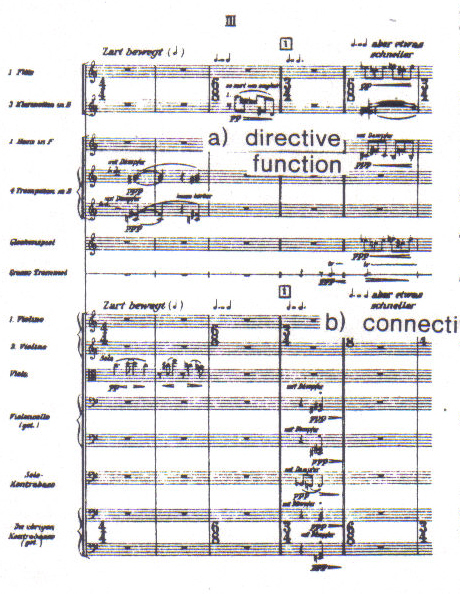

Example 5 a and b: Movement III: Directive functions (m. 3 - 9). Connective functions ((m. 4-6)
Accompanimental function refers to a part or parts within a musical texture that operate as auxiliary support for other more substantive parts. Relatively speaking, material that functions as accompaniment lacks the dynamic continuity and thrust of a primary unit of expression, i.e., thematic ideas. This subsidiary material may serve as harmonic support present in the form of static, held chords, or assume more rhythmic focus by disjunct or repetitive articulation.
Although accompaniment material is considered
subsidiary in function, its importance
should not be diminished. The way in which we perceive a particular line or melody is greatly
influenced by the context created by its accompaniment. A major case in point is found in Movement V
of the
Six
Pieces.
A constant renewal of uniqueness, befitting Webern's intention of maintaining "changing modes of expression"12,
is achieved in the accompanimental materials. The composer does this by alternating the accompanimental chords between several instrumental groups, i.e., several timbral units: Strings-Bass-StringsReed-Strings-Brass
and o forth. (see Example 6)

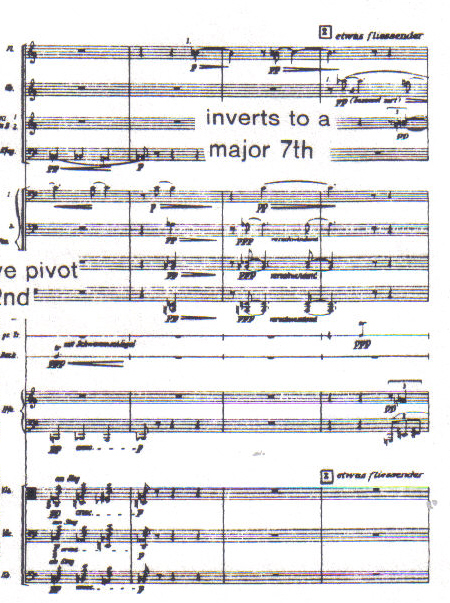
Example 6 a and b: Movement V: Connective functions (pivot m. 4 - 7) Accompaniment (m. 1-4)
Detailed Analysis of Movement III
The following detailed analysis of Movement III from the Six Pieces for Orchestra will demonstrate the compositional procedures of Anton Webern and the unprecedented perspectives that were taken by the composer with regard to musical materials. The ensuing analytical discussion will be based on the premise that traditional forms provided Webern with initial structural models around which he could project and develop his particular musical concerns. In The Path to the New Music, Webern wrote:
• • • we have not yet advanced beyond the classical composer's forms. What happened after them was only alteration, extension, abbreviation; but the forms remained, even in Schoenberg!13
And also in Webern! Movement Ill reflects the ternary structure of a short song form within which the presentation of musical events follows an ordering similar to the canonic procedure of retrograde. However, as a result of the composer's interest in exploring the possible alternatives to tonality and its system of key relationships (tonal dissolution), his aim for "an always changing mode of expression,"14 and the "avoidance of (traditional) thematic connections,"15 substantial modifications of the organizational models used are noticeable. Nevertheless, Webern's aesthetic concerns are never compromised.
Movement III is in ternary form with a palindrome-like construction. This movement is not an exact note-by-note account of a true palindrome. However, it manifests such construction strongly. The design of the movement may be represented as follows:
Section: A B
C
event: a b c d c1 b1 a1
measure: 1 2 3-4 5-6 7 8 9-11
As in any palindrome, there is a pivot point after which the reversal of the material begins (beginning mirror-like parallels between events). Take for example the sentence:
Madam I'm Adam
The pivot point in the palindrome above is "I". In Movement III, the middle section (measures 5-6) is analogous to the "I" and serves a similar pivotal function within the design of the movement. However, not only does Section B fulfill this pivotal function in the context of the macro-form but its linear configurations (both labeled "thematic" because they establish the identity of this section) form a note-by-note account of a palindrome, whose internal groupings are also palindromic. As such, the basic motive of the B section is analogous to the basic word "madam" of the sentence "Madam, I'm Adam" (Example 7) .
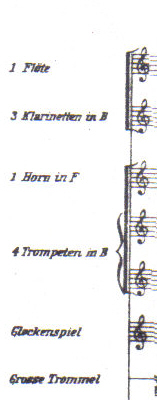
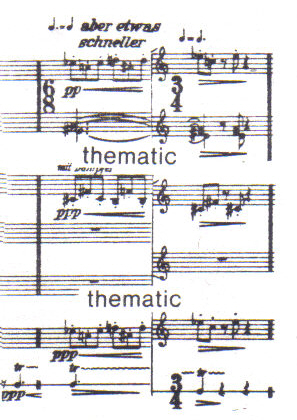
Example 7: Mvt. III Section 3. meas. 5 - 8
This tier construction with palindromes adds to the symmetrical continuity of the formal design, deepening the function that the B section fulfills. It also distinguishes measures 5 and 6 as a complete formal unit whose identity, by virtue of the nature of its organization, remains distinct from that of the outer two sections.
Webern, however, derives the working materials and the palindromic organization for this B section from the opening A section. There is no new material at this point. The extent of relatedness between Sections B and A may be measured by viewing the material, but not the function, of Section B as an elaboration on material from measure 1,
Section A.
Measure 1
contains two events, the antecedent phrase of the thematic event and the accompanimental chordal event. The antecedent phrase is characterized by: 1) a group of three articulations and
two elements, 2) a symmetrical contour in which the outer elements are
identical, and 3) a movement by uniform whole steps,
one up and one down (see Example 8). The chordal event, on the other hand, is static and its identity as a
unit is based on its intervallic components, ordered from top to
bottom, as follows: m3, M2, + 4. (This
Example 8: Movement II, Meas. 1
The thematic content of Section B consists of two linear configurations which are constructed from the basic characteristics of the original antecedent phrase listed above. Webern takes the number of articulations (3) and the number of elements (2) and employs their combination as the basis for grouping events in the new section. Hence, each line in Section B is composed of three motivic groups of which two are unique. Each group, in turn, is composed of three articulations. The controlling number of elements (2) within a group also extends to its vertical components. Therefore, the intervallic distance between simultaneous events alternates between a minor 3rd and a minor 2nd.
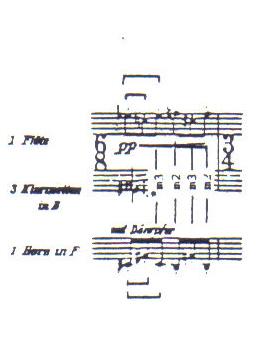
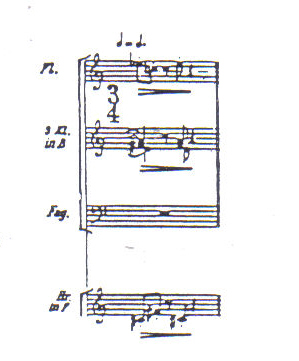
Example 9: Grouping. Sect. B. Movement III, meas. 5-6
(m3 is the contracted transportation of the original dim.7th interval)
Secondly, the characteristic symmetry of the thematic motive in measure
1 becomes the pervasive structural concern in Section
B. A symmetrical contour
Thirdly, the
thematic configuration designated as "primary" in Section B is given such distinction because it outlines a transposed
version (up a minor 3rd) of the original
thematic motive,
e17-f-e replacing
c-d-c respectively. This motive
may be traced in the primary configuration by considering the pitches that share a common means of emphasis through repetition,
i.e., the outer members of each motivic
group. (Example 10)
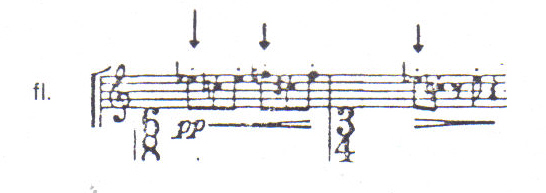
Example 10: Outline of original motive. Sect. B, meas. 5-6
The inner members of
each motivic group, the pivotal pitches c-c#-c, are by no means inconsequential. They duplicate the major
pitch elements and contour of the complete
antecedent-consequent thematic statement of
measures 1
and 2
(see Example 11).

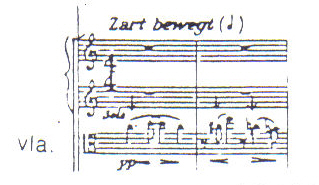
Example 11: Duplication of original theme in skeletal form. Section B, Mvt. III
These pitch elements respectively begin the theme's three motivic groups and are weighted through repetition (the pitch c) or by its position within the intervallic outline (c# is the lower member of the major 3rd interval). These pitch elements, c-c#-c, also form a very similar but distinct contour to the opening motive of measure 1, differing only in the intervallic distance between its elements (half-step difference). The c-c#-c movement may be considered to provide the skeletal contour of the thematic statement in Section A. However, the situation in Section B is such that a representation of this contour is overlapped beneath the magnified contour representation of the antecedent phrase of measure 1, therefore assuming a more subdued position. It re-emerges in Section A1 (transposed to g) as the concluding thematic statement.
The accompanimentat chordal figure in Section B which is an exact transposition of the original figure in measure 1 (down a half-step), complements the upward transposition of the higher figure, and also retains a similar static disposition. Therefore, it does not interfere with the symmetrical nature of the thematic event. (Example 12)
At the onset of measure 5, the chordal unit is incomplete. The bottom-most pitch, forming the tritone base of the chordal unit, does not appear until measure 6, at the end of Section B. Webern not only separates this pitch (A flat) from the composite unit but also gives it added emphasis by presenting it as a very high harmonic (violin I), inverting the original bass position of this element. However, the major significance of the heightened emphasis on the A flat lies in the dual function that this pitch element carries out within Section B. It completes the chordal event (accompanimental function) and also serves as the leading tone to the cadence on the pitch a (directive function, leading to a primary function) .
Yet another function of the A flat is fulfilled in relation to the rest of the movement. It serves a connective function, linking Section B to the closing Section A1, by extending into the closing section. One could view the a as a link within a chain of sections comprising the movement. The Bass Drum pedal trill is the mirror-like counterpart to the A flat. It is the lowest pitch element as the a harmonic is the highest one and fulfills a similar connective function, linking the opening Section A, to Section B (Example 5). The A flat also creates anticipation for the A contained in the concluding thematic event in Section A1 by its extension so far into this final section (Example 12).
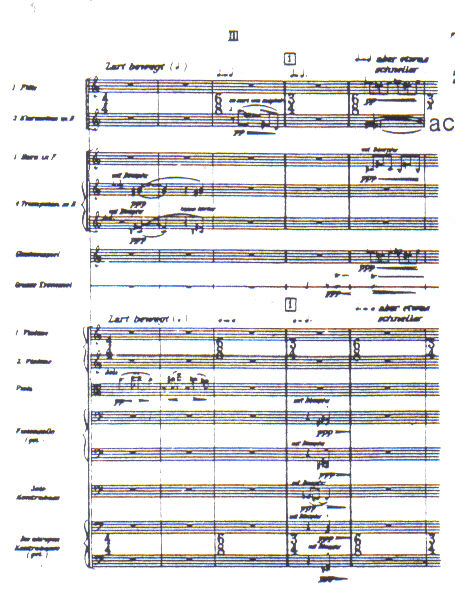
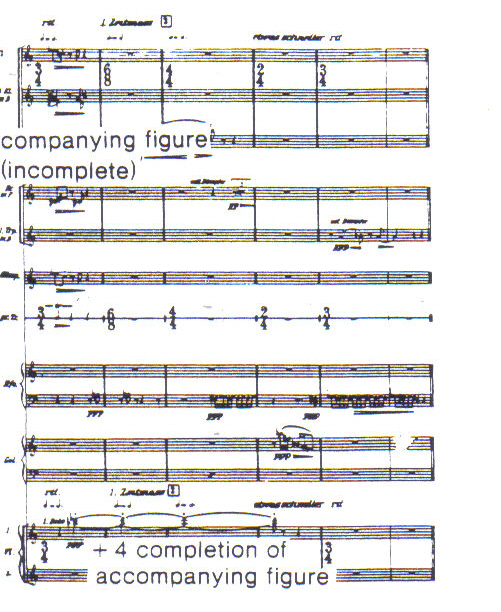
Example 12: Accompanying event, its completion at m. 5, significance of a harmonic Section B, Movement V
The articulation on the pitch a (harp) concludes Section B. However, this element is not an extension of previous thematic or accompanimental material from Section A, but appropriately reiterates an important component of the cadential chord from the previous section (Example 12).
There are two focal pitches within the cadential event of measure 4, f and a. The pitch f is the resolution or arrival point of the linear movement within the section and a is the root of the vertical cadential sonority (a-c#-e-g#). The order of arrival should be noted, F preceding A, because the reversal of its order (A preceding F) indicates the beginning of the corresponding half of the mirror image within the palindromic design of Movement Ill (measure 7). Section B's cadence on A , immediately preceding the a in measure 7 (Section A1), anticipates this retracing of material and events.
The contiguous reiteration of the pitch a, in turn, adds strength to its focus as a cadence point and as a pivot point in the mirror image.
In summary, Section B is characterized by vertical and horizontal mirroring (mirror in the sense of retrograde) of materials which provides the symmetrical continuity and morphology of the formal unit. This symmetry, in turn, is at the root of the pivot function that the section fulfills in context to the large palindromic design of the movement. It is by virtue of its mirrored treatment of musical materials that Section B is distinct from Section A and Section A1.
In general, Webern succeeds in achieving his aesthetic concern for comprehensibility in Section B through an extremely high degree of relatedness to material from the opening Section A, yet still achieves a different and distinct mode of expression through the pervasive and complete exploration of symmetry. However, the composer's remark regarding the lack of "thematic connections between and within movements" is contradictory here unless one considers the following aspects of design and intent:
1) Thematic reiteration as a means of establishing formal parallels is relevant to the outer A sections of a ternary song form. However, it is not equally relevant to the middle section. This B section is based on the principle of contrast and differentiation either in the form of new thematic material or distinguished by the process(es) or procedures that are applied to previous material, e.g., development.
2)
Webern considered Movement III
to be an introduction to Movement IV
The outer sections, A and A . are complementary units in the palindromic design of Movement Ill. A1 is not an exact note-by-note mirror duplication of Section A, in that it contains certain permutations of elements and materials. Nevertheless, the basis of its organization is the retrograding of events and conditions found in the opening A section.
There are four major events in Section A that fulfill four distinct functions: thematic, accompanimental, directive, and cadential (see Example 13). Although these events in Section A will generally be referred to by the functions they fulfill, it should be kept in mind that the retrograde of these events, in permuted form, in Section A1 does not necessarily conserve their original functions.
Example 13: Event and their functions Sect. A Meas. 1-4
The events of section A have particular characteristics and circumstances. First of all, in measures 1 and 2, a paired relationship exists between the thematic event (composed of antecedent and consequent statements) and the chordal accompanimental event. (The accompaniment, in essence, fulfills a subsidiary or auxiliary function to the primary thematic function.) This simultaneous overlay of theme and accompaniment may also be thought of as a kind of dynamic state balanced against a static one.
Secondly, in measure 3, the directive event is observed to be a singular, unidirectional figure (high to low). This also fulfills a subsidiary function which ultimately leads or points to material maintaining a primary function. In this instance, it directs the listener's attention to the cadential event. The material of this descending configuration of measure 3 is based primarily on the intervallic components of the previous consequent phrase in measure 2. As such, this directive event of measure 3 may also be thought of as an extension of the consequent phrase.
Thirdly, in measure 4, the cadential event has two resolutions, on pitches f and a. The order of resolution is important, f preceding a, because this order will be reversed in Section A1.
Section A1 (measures 7-11)presents the retrograde order of the four events in Section A, with certain modifications. Fundamentally, the opening Section (measures 1-4) has two types of configurations: chordal and linear. In the closing A1section, all configurations are linear. It is possible to maintain a palindromic correspondence between A and A1 because the accompanimental chordal event in A is transformed into linear events within A1 (i.e., vertical to horizontal alignment of the intervallic composition of the chordal event, measures 7 and 9).
It is conjectured that any distortion of the general ABA design is triggered by the linearization of the accompanimental chordal event as Webern converts its original static state into a dynamic one (ie., more movement and articulation in the transformed version). This alteration makes it impossible for the now linear configuration to appear in its original temporal disposition as event 2 superimposed upon event 1, without negating the original condition of a static state balanced against a dynamic one. Consequently, in the closing A1 section, Webern alters the original vertical alignment of Events 1 and 2 to a horizontal succession of events such that material from Event 2 (measures 7 and 9) always precedes material from Event 1 (measures 8, 10-11). Under these altered circumstances, the original paired relationship between the two events is preserved (see Example 14),
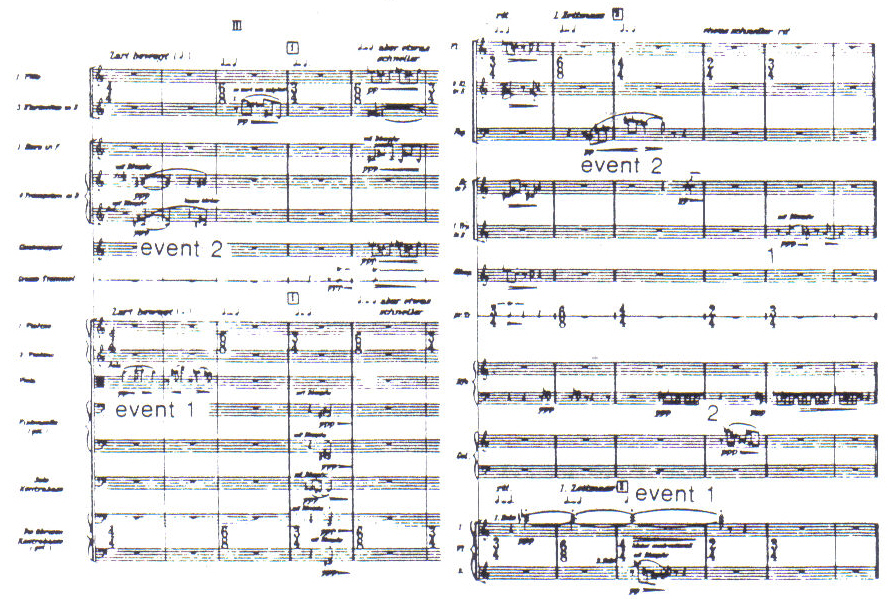
Example 14: Movement III, Section A (m.8-11), retrograde of events
All other modifications and adjustments in Section A1, affecting the palindromic design of the movement, are carried out to maintain the original circumstances and conditions (but not necessarily functions) of the four events found in Section A. (See previous discussion, p. 19)
The two
configurations within measures 7 and 9, derived from material of the accompanimental
chordal event of Section A
(Event 2), share a common set of characteristics. 1) Unlike the original event, these figures do not
function as accompaniment.
However, they fulfill a similar subsidiary function, a directive function (Example 4 above). 2) Both figures are
also unidirectional, as an ascending or
The juxtapositions of intervallic elements within these two related events are distinctly different. Material within measure 7, with the exception of the a harmonic, conforms to a permuted ordering of intervals from the original chordal event. It is the aggregate of intervals from the original chordal event, but not its ordering, which generates the pitch components in the linear configuration of measure 9. (See Example 15)
original event

modified recurrences

Example 15: Original Accompanying chord (m. 1-2) with two midified representation (m. 7, 9)
Within measure 7, Example 15b, the pitch A (harp) and the B flat of the motive B flat-G-A (bassoon) outline the exact major seventh expanse of the original chordal unit. Its outer pitch components are identical.18
Although the basic discussion of materials in measure 7 has been directed towards its derivation from the chordal accompanimental event of Section A, the importance and relevance of such material is established by the functions it: elements fulfill and their conformity with the palindromic design of Movement III. The materials of measure 7 may be classified into three separate events which carry out different functions: the connective function of the violin harmonic A batyrak (see previous discussion pg. 18), the reiterative and connective function of the harp A7th sonority (also forming palindromic relations with the closing a of the piece) and the ascending B flat -G-A which mirrors the descending clarinet figure of measure 3 and in emphasizing the a provides a tonal reflection of the cadential a in m.4.
Continuing the approach of the B flat-G-A motive, discussed above, to the f# apex of the arch-like phrase in the bassoon line (measure 8), is also carefully constructed to form a palindromic unit of intervals, i.e., major 6th (inversion of a minor 3rd), major 2nd, major 6th (minor 3rd). This internal palindrome, built on the vertical intervallic components of the original chordal event, is immediately followed by an counterbalanced with a palindromic set of intervals (measure 8) built on intervallic components of the consequent phrase of the original thematic event (measure 2), i.e., minor 2nd, minor 3rd, minor 2nd. (Example 16).
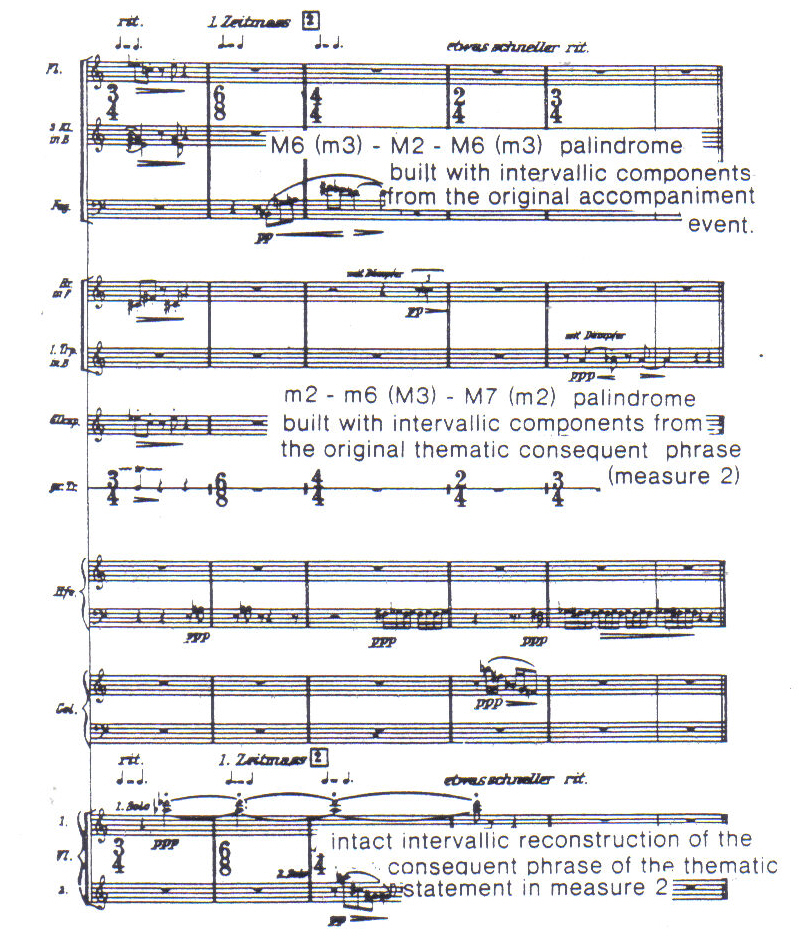
Example 16: Movement Ill, Section A'(m..7-11)
However, in the second palindromic unit of measure 8, the component pitches are further dispersed among three instruments, displaced in octave position. The bassoon line concludes with the pitches E flat and D (a minor 2nd), drops a minor sixth (the inversion of a major 3rd) to the harp's F# and up a major 7th (the inversion of a minor 2nd) to the horn's F. Although each pitch element is derived from the application of a common set of intervallic relationships, they mete out different functions which are clearly delineated by their instrumentation and registral separation.
The interval of a minor 2nd is consistently employed as a "device" .to conclude a phrase or to arrive at the cadence. Therefore, all ending points (e.g., phrase endings, cadence) within Movement III conclude with a minor 2nd interval (measures 2, 4, 6, 8, 9, and 10) the E flat and D, outlining a minor 2nd, conform to this closing formula, the E flat) functioning as an upper leading tone to the concluding pitch d within the line of the bassoon.
The repetitive f# in the harp line serves two functions. First of all, it serves as the preparation for the cadence on pitch f (horn) as an upper leading tone. Secondly, this repetitive f# figure foreshadows the f# pedal figure in the last two measures of the movement.
The cadential point on f (horn) ends the pitch motion within measure 8. It also completes the retrograde mirror presentation of the major cadential pitch components ending Section A, measure 4 (f and a).
Although the f measure 8 is not contiguous to the a (measure 7), as in the circumstance of measure 4, the general mirror correspondence between Sections A and A1remains intact. Reviewing the circumstances in measures 3 and 4 of Section A, it has been noted that the descending configuration to and including the cadential pitch f are constructed from intervallic components attributable to the previous thematic event of measure 2 (consequent phrase, major 3rd, & minor 2nd intervals). As such, this material is an extension of the consequent phrase. (the cadential pitch a is not.) In Section A1, measure 7, Webern constructs the retrograde figure corresponding to the descending configuration in measure 3 (clarinet to the bass line) with intervallic components of the chordal accompanimental event (measure 1). The mirroring of material from and including the consequent phrase is accounted for primarily in the following measure 8. Therefore, the placement of the f as a cadential pitch within measure 8 is consistent with its original association and derivation.
In addition to the pitch events, generated by the intervallic palindrome, a descending, unidirectional configuration, in the solo Violin II, overlaps and interacts in complement to the phrase ending of the bassoon line (Example 16). This motive represents an intact, reconstruction of the consequent phrase of the original thematic event in measure 2, built with identically ordered intervallic elements. Based on the premise that intervallic content serves as a point of reference from which the identity of an event may be established, the configuration in the solo Violin II (measure 8) represents the mirror counterpart to the consequent phrase of measure 2.
However, the general contour of the original event is not preserved in the measure 8 figure due to a slight alteration in the alignment of its intervallic components (major 3rd, perfect 4th, minor 2nd). By inverting the opening interval of a major 3rd to a minor 6th, and inverting its original direction from an ascending to a descending skip, a uniform descending configuration results (Example 17). As a consequence, not only does the configuration in the solo Violin 11 line represent an altered mirroring of the thematic consequent phrase of measure 2, but also assumes the contour of the thematically derived descending configuration of measure 3.
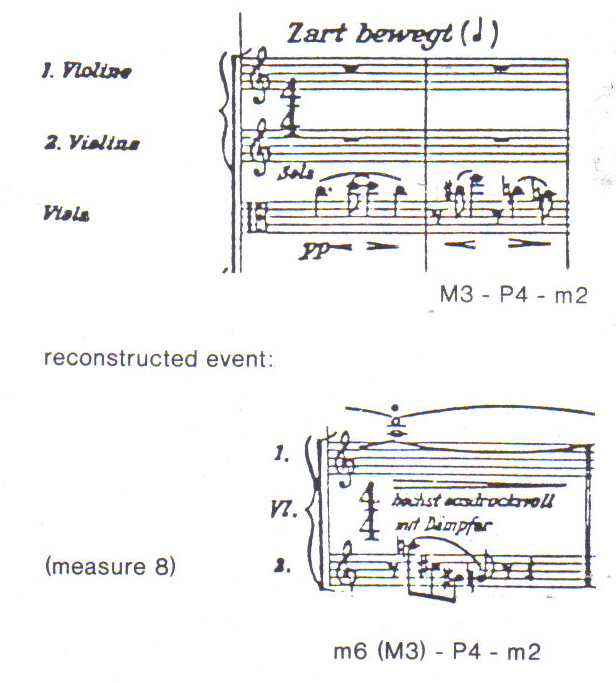
Example 17: Reconstruction of the original consequent phrase of the thematic event within Section A' (m.8)
The events and conditions within the concluding three measures, 9 through 11, reassert the circumstances evident in the opening measure of the movement, with particular modifications. The basic alteration in the form and positioning of events is the linearization of the chordal accompaniment (measure 9) which now precedes, rather than coincides with the thematic antecedent phrase (measure 10). This change, however, does not negate the original conditions. The paired relationship between the two events is still maintained, from a linear rather than a vertical perspective. Although the figure derived from the chordal event (measure 9) no longer functions as accompaniment, it still maintains a categorically similar, subsidiary function, a directive one. The descending, unidirectional gesture of this configuration propels the movement towards its last pitch element, F#. The original circumstance of a dynamic state (theme) balanced against a static one (accompaniment) is then adequately reproduced by the prolongation of the F# as a cadential pedal concurrent with the thematic statement in measures 10 and 11.
Although the F# is derived from the same array of intervals as the descending configuration of measure 9, it fulfills a different and weightier (i.e., cadential) function. Its separate assignment to the harp highlights the pitch's distinction and is consistent with the instrumental assignment of the previous F# figure in measure 8.
Concurrent with the F# pedal in measure 10 and 11, the motive G-A flat-G (trumpet) expresses the concluding statement of the movement, restoring the general contour associated with the opening thematic motive of measure 1 (antecedent phrase). In this respect, a parallel may be drawn between the opening statement and the concluding statement of the movement.
Also, consistent with Webern's previous modifications in the mirror correspondence between events of Sections A and A1, the G-A flat-G motive of measures 10 and 11 extends beyond the mere contour representation of its measure 1 counterpart. This statement actually presents the skeletal outline of the complete antecedent-consequent thematic statement encountered in measures 1 and 2 (viola). Moreover, by virtue of the durational values of its articulations, the G-A flat-G motive appropriately retraces the points in the outline in retrograde (Example I8). In essence, this concluding thematic event, carried by the trumpet, functions as a short retrograde summary of the major thematic statement of the movement.19
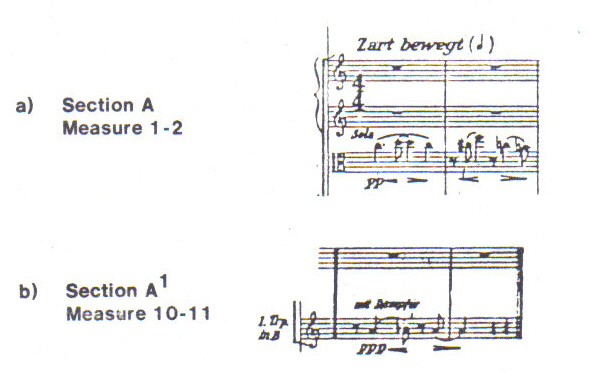
Example18: Section A1, meas. 10-11; Skeletal outline of thoemati statement (meas. 1-2). Retrograde of durations.
The pitch elements of the concluding
thematic statement,
g and al.., may also be seen to emerge from
previous events. The is
initially foreshadowed
Summary
The formal design of Movement III strongly asserts the ternary structure associated with song form. Ternary form, or song form, is characterized as a sectional structure, "the sum of three single units, each complete in itself."20 Within Movement III, Section A provides a complete antecedent-consequent thematic statement and concludes with strong cadential action. Section B provides the necessary contrast that is inherent in a ternary form. However, it provides a contrasting perspective on part of the previous thematic statement from Section A, i.e., its symmetry, rather than providing new material. Nevertheless, by virtue of the symmetrical continuity of the material as a complete palindromic expression, this section maintains its own integrity as a formal unit. The closing A1 section constructs the complete, but modified, retrograde of events from the opening A section. As a consequence of this backward reference, a formal parallel between A and A1 is appropriately established without blatant thematic reiteration. Alternative ways of reconstructing events other than pitch order are employed, e.g., intervallic content, its order or array, offering a varied perspective on the original material.
The orchestral scheme of Movement Ill is designed to support structural coherence. A major change in function results in a change of instrumental timbres. Special instrumental assignments in the various sections of the movement (e.g., Section B, glockenspiel) also reinforce large structural distinctions within the ternary form.
Brevity is further a noticeable condition. Movement Ill is 11 measures long with an approximate performance time of 50 seconds.21 There is no unnecessary extension or repetition of function or material. However, because all necessary functions and requirements of form and procedure are satisfactorily fulfilled, the expressive breadth of the movement is uncompromised and belies the actual duration of the movement.
In
conclusion, Anton Webern's Six Pieces for Orchestra offers an insight
into the recourse taken by the composer to adequately accommodate his compositional choice of avoiding thematic
repetition without destroying comprehensibility, i.e., structural coherence. The
composer's perceptive assessment of the
fundamental
structural properties within the classical forms and contrapuntal
Intervallic content (the order and
aggregate), timbral succession (e.g., klangfarbenmelodie), and conditions or
circumstances arising
from the juxtaposition of elements or events (linear, and vertical), are treated
as major musical constructs
that supercede pitch succession as a means of
establishing formal parallels.
These constructs do not adhere to the tonal scheme of key relationships (a
prescribed order of expectations). Webern is thus
freed from the constraints of tonality without loss of
structural unity.
Bibliography
Boulez, Pierre.
"Anton Webern," Notes of an
Apprenticeship.
New York: Alfred
A. Knopf, 1968, 377-391.
Craft, Robert. "Anton Webern," The
Score, XIII (1955), 9-22.
Eimert, Herbert.
"A Change of Focus," die Reihe, Volume
2 (Second revised edition), 1975, p. 29-36.
Isaac, Heinrich.
Choralis Constantinus,
Part 11. Edited by Anton Webern.
Published in Denkmaler
der Tonkunst in Osterreich, edited by Guido Adler. Graz: Akademische Druck, U. Verlagsanstalt, 1959.
Introduction translated by Else Geissmar,
1979 (unpublished).
Kolneder, Walter. Anton
Webern: An Introduction to His Works. Berkeley
& Los Angeles: University of California Press,
1968.
Leibowitz, Rene. Schoenberg and His School. Translated
from the French by Dika
Newlin.
New York: Da Capo Press (1st paperback printing, 1975). 305 p.
Moldenhauer, Hans, and Rosaleen
Moldenhauer.
Anton von Webern: A Chronicle of His Life and Work. New York: Alfred A. Knopf, 1979. 803
p
Moldenhauer, Hans, and Demar Irvine. Anton von Webern Perspectives. Seattle: University of Washington Press, 1966. 191
p.
Webern, Anton.
"Choralis Constantinus,"
die Reihe, Vol. 2, 1958, pp. 22-25. Translated from the German by Leo Black.
Webern, Anton. 6 Stücke für
Orchester, Opus 6 (Original version, 1909).
Universal Edition, 1961. 33 p.
Webern, Anton. Sechs Stacke fur Orchester,
Opus 6 (Revised version, 1928). Universal Edition, 1956. 29 p.
Webern,
Anton. The Path to the New Music. Edited by Willi
Reich, translated from the German by Leo Black. New Jersey: Universal Edition, 1975. 67 p.
Wildgans, Friedrich. Anton
Webern. Translated by Edith
Temple Roberts
and Humphrey Searle. London:
Calder and Boyars, 1966. 185 p.
1This paper is
excerpted from chapters two and three of Jeri Kotani's
Master's Thesis entitled
"An Analysis of
Anton Webern's
Six Pieces for Orchestra
Opus 6" 1980 which is available through
the UCSD
Central Library.
2
Opus 6 was written during the tenuous period of atonal
experimentation. By avoiding tonality
and testing new
approaches, Webern gained the experience necessary to
enable him to formulate the
dialectic position advanced in
The Path to the New Music.
3
Anton Webern,
The Path
to
the New Music,
(Universal Edition,
1960), p. 17.
4Webern,
The Path
to
the New
Music,
p. 22.
5
Anton Webern, program notes originally published in the Zeitschrift fur Musik. Translated
in:
Hans Moldenhauer, Anton
Webern: A Chronicle of His Life and Work, (Alfred
A. Knopf, New York,
1979), p. 128.
6 Ibid.
7 Webern, The Path to the New Music, p. 42.
8
Wili Apel, Harvard Dictionary of Music, (Belknap Press of
Harvard University Press, 1969),
p. 843.
9
Apel, Harvard Dictionary, p. 118.
10 See Chapter III, page 16, of the thesis. Opus 6 is not
completely free from tonal motivations
and their
manifestations.
11
Webern, The Path to the
New Music, p. 39.
12 Moldenhauer,
Anton
WottPrn
A Chronicle,
p. 1 28.
13 Webern, The Path to the New Music, p. 36.
14 Moidenhauer, Anton Webern, A Chronicle, p. 128.
15 ibid.
16 Moldenhauer, Anton Webern, A Chronicle, p. 1 28.
17 The f# is a major pitch element in A1 whose function and importance will be presented in later discussion.
18 The linear representation of the inner pitch components,
however, differs from the original
material. Webern inverts the order of intervals such that the topmost
intervals (minor 3rd, Major 2nd) become the bottom-most intervals. Therefore,
from the B flat, the motive goes up a major 6th (the inverted form of a minor 3rd), to a
G,
and up a major
2nd thereafter to A.
This pitch a may be said to
represent
both an inner pitch component (by virtue of its position within the intervallic
order) and an
outer (topmost) pitch component. It is
conjectured that because of this duplication of positions by the
a,
the need to incorporate the remaining interval of a tritone,
generating another pitch component and
position, was not
necessary. With
A natural,
Webern had arrived at the outer limits of the
original
chord,
19 Pitch becomes a
background nuance which therefore implies rather than directly asserts or
addresses, the importance of the a-flat element. The factor which
strengthens the projection of the
a-flat element (measures 6 through 9)
is the extreme duration of its pedal figure.
20 ApeI, Harvard
Dictionary of Music, p. 95.
21
Moldenhauer, Anton Webern: A Chronicle, p.
129.